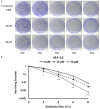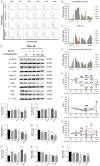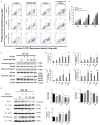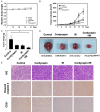Cordycepin enhances radiosensitivity to induce apoptosis through cell cycle arrest, caspase pathway and ER stress in MA-10 mouse Leydig tumor cells
- PMID: 36119830
- PMCID: PMC9441998
Cordycepin enhances radiosensitivity to induce apoptosis through cell cycle arrest, caspase pathway and ER stress in MA-10 mouse Leydig tumor cells
Abstract
Radiotherapy is a localized treatment commonly used in various types of cancer. However, major limitation of radiotherapy is the development of resistance of tumor cells to radiosensitivity. Cordycepin, a predominant functional component of the Cordyceps sinensis, is considered to use in treating tumor cells. In the present study, we investigated the anticancer effect of the combination of radiation and cordycepin in the treatment of Leydig tumor cells. Results showed that the combination treatment has a synergistic effect significantly suppress cell viability and enhance the radiosensitivity in MA-10 mouse Leydig tumor cells. The combination treatment induced MA-10 cell apoptosis through increasing levels of cleaved caspase-3/-8/-9, poly ADP-ribose polymerase (PARP), and cytochrome c and decreasing levels of B-cell lymphoma 2 (Bcl-2). In addition, prolonged sub-G1 and G2/M arrest accompany with cell cycle-related protein regulation was observed in cells that received the combination treatment. The endoplasmic reticulum (ER) stress-related protein expressions were regulated after MA-10 cells treating with a combination of 100 μM cordycepin and 4 Gy radiation. Furthermore, the combination treatment also decreased the Leydig tumor mass by increasing cell apoptosis in tumor-bearing mice. In conclusion, cordycepin enhances radiosensitivity to induce mouse Leydig tumor cells toward apoptosis in vitro and in vivo. This study will provide a scientific basis for the development of therapeutic regimen of testicular cancer.
Keywords: Cordycepin; ER stress; Leydig tumor cell; MA-10 cell; apoptosis; caspase; cell cycle; radiation.
AJCR Copyright © 2022.
Conflict of interest statement
None.
Figures








Similar articles
-
Combination treatment of cordycepin and radiation induces MA-10 mouse Leydig tumor cell death via ROS accumulation and DNA damage.Am J Cancer Res. 2023 Apr 15;13(4):1329-1346. eCollection 2023. Am J Cancer Res. 2023. PMID: 37168338 Free PMC article.
-
Cordycepin inhibits ERK pathway to suppress FGF9-induced tumorigenesis with MA-10 mouse Leydig tumor cells.J Food Drug Anal. 2023 Aug 31;31(3):485-501. doi: 10.38212/2224-6614.3464. J Food Drug Anal. 2023. PMID: 39666281 Free PMC article.
-
Anti-Cancer Effect of Cordycepin on FGF9-Induced Testicular Tumorigenesis.Int J Mol Sci. 2020 Nov 6;21(21):8336. doi: 10.3390/ijms21218336. Int J Mol Sci. 2020. PMID: 33172093 Free PMC article.
-
Functional study of Cordyceps sinensis and cordycepin in male reproduction: A review.J Food Drug Anal. 2017 Jan;25(1):197-205. doi: 10.1016/j.jfda.2016.10.020. Epub 2016 Dec 8. J Food Drug Anal. 2017. PMID: 28911537 Free PMC article. Review.
-
Cordycepin in Anticancer Research: Molecular Mechanism of Therapeutic Effects.Curr Med Chem. 2020;27(6):983-996. doi: 10.2174/0929867325666181001105749. Curr Med Chem. 2020. PMID: 30277143 Review.
Cited by
-
Combination treatment of cordycepin and radiation induces MA-10 mouse Leydig tumor cell death via ROS accumulation and DNA damage.Am J Cancer Res. 2023 Apr 15;13(4):1329-1346. eCollection 2023. Am J Cancer Res. 2023. PMID: 37168338 Free PMC article.
-
Cordycepin Activates Autophagy to Suppress FGF9-induced TM3 Mouse Leydig Progenitor Cell Proliferation.Cancer Genomics Proteomics. 2024 Nov-Dec;21(6):630-644. doi: 10.21873/cgp.20479. Cancer Genomics Proteomics. 2024. PMID: 39467624 Free PMC article.
-
Application and research progress of cordycepin in the treatment of tumours (Review).Mol Med Rep. 2024 Sep;30(3):161. doi: 10.3892/mmr.2024.13285. Epub 2024 Jul 12. Mol Med Rep. 2024. PMID: 38994776 Free PMC article. Review.
-
The therapeutic potential of natural products for treating pancreatic cancer.Front Pharmacol. 2022 Nov 2;13:1051952. doi: 10.3389/fphar.2022.1051952. eCollection 2022. Front Pharmacol. 2022. PMID: 36408249 Free PMC article. Review.
-
Sodium arsenite and dimethylarsenic acid induces apoptosis in OC3 oral cavity cancer cells.Mol Med Rep. 2023 Feb;27(2):26. doi: 10.3892/mmr.2022.12913. Epub 2022 Dec 16. Mol Med Rep. 2023. PMID: 36524366 Free PMC article.
References
-
- Richiardi L, Scelo G, Boffetta P, Hemminki K, Pukkala E, Olsen JH, Weiderpass E, Tracey E, Brewster DH, McBride ML, Kliewer EV, Tonita JM, Pompe-Kirn V, Kee-Seng C, Jonasson JG, Martos C, Brennan P. Second malignancies among survivors of germ-cell testicular cancer: a pooled analysis between 13 cancer registries. Int J Cancer. 2007;120:623–631. - PubMed
-
- Petersen PM, Skakkebaek NE, Rorth M, Giwercman A. Semen quality and reproductive hormones before and after orchiectomy in men with testicular cancer. J Urol. 1999;161:822–826. - PubMed
LinkOut - more resources
Full Text Sources
Research Materials
